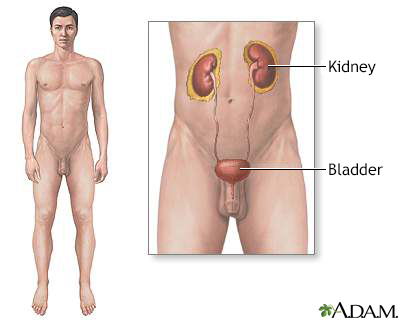Pregnancy SmartSiteTM
Segmental glomerulosclerosis; Focal sclerosis with hyalinosis DefinitionFocal segmental glomerulosclerosis is scar tissue in the filtering unit of the kidney. This structure is called the glomerulus. The glomeruli serve as filters that help the body get rid of harmful substances. Each kidney has thousands of glomeruli. "Focal" means that some of the glomeruli become scarred. Others remain normal. "Segmental" means that only part of an individual glomerulus is damaged. CausesThe cause of focal segmental glomerulosclerosis is often unknown. The condition affects both children and adults. It occurs slightly more often in men and boys. It is also more common in African Americans. Focal segmental glomerulosclerosis causes up to a quarter of all cases of nephrotic syndrome. Known causes include:
SymptomsSymptoms may include:
Exams and TestsThe health care provider will perform a physical exam. This exam may show tissue swelling (edema) and high blood pressure. Signs of kidney (renal) failure and excess fluid may develop as the condition gets worse. Tests may include:
TreatmentTreatments may include:
The goal of treatment is to control the symptoms of nephrotic syndrome and prevent chronic kidney disease or failure. These treatments may include:
Outlook (Prognosis)A large portion of people with focal or segmental glomerulosclerosis will develop chronic kidney disease or failure. Possible ComplicationsComplications may include:
When to Contact a Medical ProfessionalContact your provider if you develop symptoms of this condition, especially if there is: PreventionNo prevention is known. ReferencesAppel GB, D'Agati VD. Primary and secondary (non-genetic) causes of focal and segmental glomerulosclerosis. In: Feehally J, Floege J, Tonelli M, Johnson RJ, eds. Comprehensive Clinical Nephrology. 6th ed. Philadelphia, PA: Elsevier; 2019:chap 18. Radhakrishnan J, Appel GB. Glomerular disorders and nephrotic syndromes. In: Goldman L, Schafer AI, eds. Goldman-Cecil Medicine. 26th ed. Philadelphia, PA: Elsevier; 2020:chap 113. Saha MK, Pendergraft WF, Jennette JC, Falk RJ. Primary glomerular disease. In: Yu ASL, Chertow GM, Luyckx VA, Marsden PA, Skorecki K, Taal MW, eds. Brenner and Rector's The Kidney. 11th ed. Philadelphia, PA: Elsevier; 2020:chap 31. | |
| |
Review Date: 4/12/2023 Reviewed By: Walead Latif, MD, Nephrologist and Clinical Associate Professor, Rutgers Medical School, Newark, NJ. Review provided by VeriMed Healthcare Network. Also reviewed by David C. Dugdale, MD, Medical Director, Brenda Conaway, Editorial Director, and the A.D.A.M. Editorial team. The information provided herein should not be used during any medical emergency or for the diagnosis or treatment of any medical condition. A licensed medical professional should be consulted for diagnosis and treatment of any and all medical conditions. Links to other sites are provided for information only -- they do not constitute endorsements of those other sites. No warranty of any kind, either expressed or implied, is made as to the accuracy, reliability, timeliness, or correctness of any translations made by a third-party service of the information provided herein into any other language. © 1997- A.D.A.M., a business unit of Ebix, Inc. Any duplication or distribution of the information contained herein is strictly prohibited. | |

 Male urinary syste
Male urinary syste
